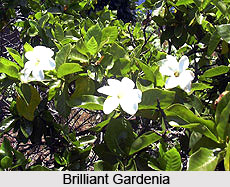 Among the several varieties of the Gardenia shrubs, the `Brilliant Gardenia` is the one that grows wildly in India. The scientific name of this shrub is `Gardenia Lucida`. It derived from the family of `Rubiaceae`. In Hindi, people call it as `Dikmala`. It is known as `Kambil` or `Kumbai` in the language of Tamil. The Telugu people named it as `Yern Bikki`, `Karinguva` and `Terra Manga`. It is also called as `White Emetic Nut` in English.
Among the several varieties of the Gardenia shrubs, the `Brilliant Gardenia` is the one that grows wildly in India. The scientific name of this shrub is `Gardenia Lucida`. It derived from the family of `Rubiaceae`. In Hindi, people call it as `Dikmala`. It is known as `Kambil` or `Kumbai` in the language of Tamil. The Telugu people named it as `Yern Bikki`, `Karinguva` and `Terra Manga`. It is also called as `White Emetic Nut` in English.
The Shrub is a common one in the drier districts of India. It can also be found in the deciduous forests of Southwest India and from Madras up through the Deccan to Chittagong in Bangladesh and into Burma. This is really a very nice and beautiful shrub. Sometimes it is like a small Shrub. It is lighter in the form and colour than the garden `Gardenia`. The cracking bark of the `Brilliant Gardenia` is paler and greenish-grey in colour. The leaves are of a bright, clear green colour. The leaves also display a substance that gives them a polished look. Though the single flowers of this shrub are a little smaller, they bear equally strong perfume. They grow singly on short stalks, in the axils of the terminal leaves. They also have five oval shaped petals that rise from a long tube clothed in soft hairs. These flowers turn to yellowish colour before they fall down.
The fruit of the `Brilliant Gardenia` is woody. It is a soft, 2.5 cm across ball. This ball remains stamped with lines that are circling the surface from the calyx. People can exude a clear and aromatic gum from the tips of young shoots and buds. This material that is famous as `Dikamali` or `Cumbi-gum` can also be produced from another species of `Gardenia`. People sale this gum in the markets either as drops or resin that is still sticking to the severed branch tips. After being purified, it becomes transparent and bright yellow in colour and then it can be used to assist teething in children. Not only this, if you melt this in spirits it can become very much effective for cleaning ulcers and sores. Being melted in oil and applied to the forehead, it provides a relief to sufferers from headaches. The hard, close-grained wood of this shrub is of yellowish-white colour and people use this for making small turned articles.











